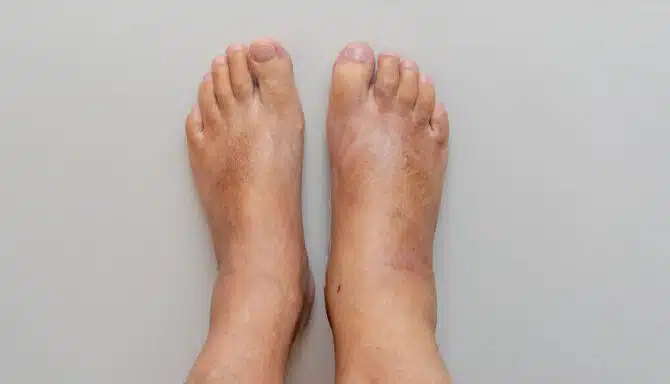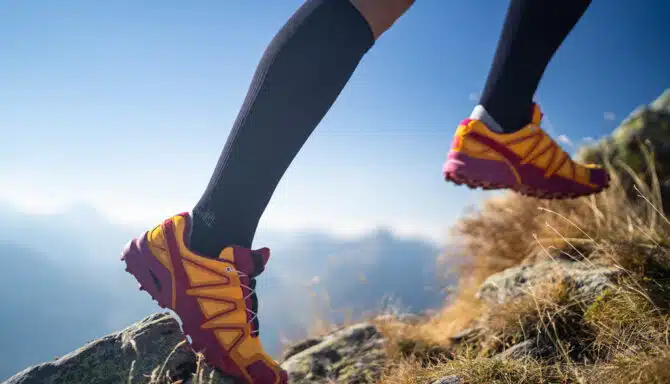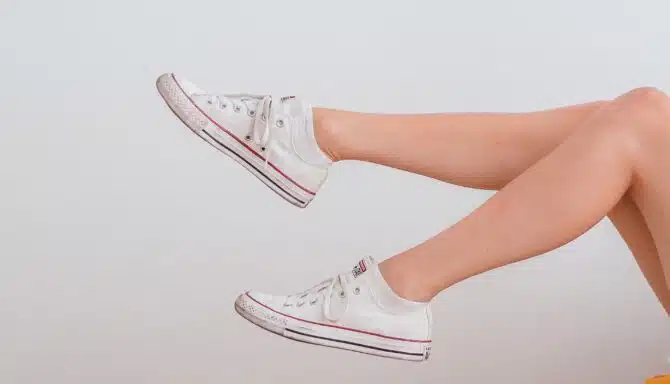November 28, 2024
Whether caused by an injury, circulation problems, or a chronic condition, foot and ankle swelling shouldn't be ignored. In this blog, we'll explore potential causes of swelling, when it might be a sign of something more serious, and how seeing a foot specialist at a Toronto foot clinic can help you get back on your feet.
What is Foot Swelling?
https://www.youtube.com/shorts/dFZVG-2ymxY
The medical term for foot and ankle swelling is called edema. This term can also be used for swelling in other body parts. It is an accumulation of fluid leaking from small blood vessels into the tissues of the foot and ankle. This causes the area to appear puffy or enlarged.
Swelling in the feet often occurs because of circulation issues, injuries, infections, or underlying health conditions. The lower extremities are especially vulnerable to swelling because gravity naturally pulls fluids downwards.
The body’s circulatory and lymphatic systems typically manage this fluid, but when they’re not functioning optimally, fluid retention can occur. Your body’s inflamatory response to foot and ankle injuries, hormonal changes (pregnancy, etc.) and increased blood volume can also lead to swelling.
Edema in the feet can range from a mild inconvenience to extremely distressing and debilitating. It can affect your gait pattern (the way you walk), make buying shoes that fit almost impossible, and coincide with other uncomfortable symptoms. You shouldn’t ignore foot and ankle swelling, even if you think you know the cause. This is because:
It can get progressively worse
It can signal a health condition you weren’t aware you had
It can be a sign that a foot injury is more serious than you thought
It can lead to other complications
It may require prompt treatment
Causes of Swollen Feet and Ankles
There are numerous causes of swollen feet and ankles. Some are mild and going away over time, while others are more severe and debilitating and may require consistent assessments and check-ups with either a physician or a foot specialist, like a chiropodist or podiatrist. If you notice swelling within your feet that is new then discuss with with you physician. Common causes of foot and ankle swelling include:
Injury. Sprains, fractures, and strains can cause localized swelling due to inflammation in the injured tissues. To protect yourself, check out the best ways to prevent foot injuries.
Infections. Conditions like cellulitis, a bacterial skin infection, can lead to swelling, redness, and warmth in the affected area.
Venous insufficiency. This is a term for damaged vein valves and in some circumstances be caused by deep vein thrombosis (DVT) or malformation in the leg veins. General venous insufficiency is common especially as we age. Poor blood flow from the legs back to the heart causes fluid buildup, leading to swelling in the lower legs and feet.
Lymphedema. Blocked or damaged lymphatic vessels prevent fluid drainage, causing chronic swelling, often in one leg or foot.
Heart, kidney, or liver disease. These conditions can disrupt fluid balance in the body, leading to retention in the feet and ankles.
Pregnancy: Increased blood volume and pressure from the growing uterus can cause fluid accumulation, especially in the lower extremities.
Prolonged standing or sitting. Sitting in one position OR standing for extended periods can cause fluid to pool in the legs and feet due to gravity. Office workers, restaurant servers, cooks, flight attendants, and more can experience mild swelling simply due to their occupation.
Gout. Gout is a type of arthritis caused by high levels of uric acid in the blood, leading to the formation of urate crystals in joints. The result is intense burning pain, redness, and swelling, particularly in the big toe. Improving your diet may be able to help with flair ups.
Diabetes: The top of the feet and ankles can swell due to nerve damage caused by diabetic neuropathy.
Diet. High sodium diets can cause excessive swelling in the legs.
Signs Your Swollen Feet and Ankles May be Serious
https://www.youtube.com/shorts/dD0T2wUUFdQ
Below are some coinciding symptoms that may be tell-tale sign of a health condition. As always, if anything is new, then to see your physician rather than to leave it:
Burning sensation. Persistent burning in the feet along with swelling could indicate nerve damage.
Redness and warmth. Swelling accompanied by redness, warmth, and tenderness may signal an infection, such as cellulitis, that needs attention.
Sudden onset of swelling. Rapid or sudden swelling in one leg could indicate a blood clot or deep vein thrombosis (DVT)s. This condition requires urgent care.
Pain: Severe pain along with swelling, especially after an injury, may point to a fracture or ligament damage.
Swelling in one foot only: Sometimes localized issues can indicate a more severe and specific problem.
Shortness of breath or chest pain. These symptoms can indicate heart or lung issues, like congestive heart failure, and requires immediate medical help.
Skin Changes: Discolored, tight, or shiny skin over swollen areas may suggest lymphatic or circulatory issues needing evaluation. Red toes or dark blue skin can signify peripheral artery disease, coronary heart disease, high blood pressure and more.
Persistent or worsening swelling. Swelling that doesn’t improve or worsens over time could be a sign of an underlying health condition that needs treatment.
When to See a Podiatrist or Chiropodist: Treatment
https://www.youtube.com/shorts/IryRcL4JPjI
You should always see a physician or foot specialist if you’re experiencing discomfort in any capacity. Remember: foot issues are not “normal.”
Because foot and ankle swelling is usually caused by an underlying medical condition, you should first see your family doctor. They can refer you to the appropriate specialists and run the necessary testing to determine what is causing the swelling. Your treatment options may target edema directly, or they may target the underlying health condition.
Once you determine the underlying cause of the foot swelling, a foot specialist or foot clinic can provide solutions to manage and accommodate the condition, so you can live your life as comfortably as possible. Below are some services a foot clinic can offer to help foot and ankle swelling:
Compression Socks
Compression stockings are a great option for venous insufficiency, pregnancy, fatigue-related swelling, and sometimes even underlying health conditions like lymphadema. They reduce swelling by promoting blood flow and limiting fluid buildup in the lower extremities. A common myth is that they are clunky, noticeable medical devices that clash with your clothing, but they are actually quite fashionable and sleek. Most people will not even realize you are wearing them.
You can get standard knee-high socks or even pantyhose, depending on how your activities and how you want to dress them up. You can get a prescription from a physician, and then stop by our Toronto foot clinic, where our certified fitters can measure you and help you select the best stockings for you.
As compression stockings can be contraindicated for some conditions (like diabetes and periphery artery disease), it's strongly recommended that you first visit discuss compression stockings with your family doctor if you have any underlying health concerns.
Orthopedic Footwear
Orthopedic shoes can accommodate swelling by offering several key features designed to provide comfort and support:
Adjustable straps and laces. Many orthopedic shoes come with adjustable fastenings that allow for a customizable fit, accommodating changes in foot size due to swelling.
Wide toe boxes. These shoes often have a wider, more spacious toe area, which helps to prevent pressure on swollen feet and allows room for expansion.
Elastic materials. Some orthopedic shoes are made with elastic or stretchable fabrics, allowing them to gently conform to the shape of the foot and adjust to fluctuations in swelling throughout the day.
Extra depth. Orthopedic shoes often have a deeper design, providing more room for foot swelling and preventing tightness that could worsen discomfort.
By combining these features, orthopedic shoes can help manage swelling while providing the support needed for optimal foot health.
Diabetic Foot Care
https://www.youtube.com/shorts/4P3UiDSFzr4
If your edema is caused by diabetic neuropathy or periphery artery disease, diabetic foot care at a foot clinic should be a part of your monthly routine. At a diabetic foot care appointment, your chiropodist will monitor your foot health. They'll examine your feet to check for sensation, circulation, and check for any potential causes for concerns - like disease progression and worsening circulation issues. Routine diabetic foot care also involves wound and nail care, diabetic foot education, and more. While these practices don’t directly target swelling, they are all interconnected and help reduce the risk of complications that can worsen swelling.
Biomechanical Assessment
If your swelling coincides with an injury and other chronic foot pain, a biomechanical assessment and gait analysis with a chiropodist can help. A chiropodist can then diagnose any underlying muscular or biomechanical issues that are causing or contributing to the foot pain, and make treatment recommendations like custom orthotics.
Additional Swollen Foot and Ankle Treatments
RICE Method
The RICE method is an acronym for a popular at-home treatment routine for acute foot injuries: rest (avoiding activities that strain the foot), ice (applying cold packs to reduce swelling and pain), compression (using bandages, tape, compression socks, and more to limit swelling), and elevation (raising the foot above heart level to help drain excess fluid). If you're
Treatments That Target Underlying Health Conditions
When foot swelling is linked to serious underlying health conditions, treatments aim to address the root cause and prevent further complications.
For example, conditions like heart failure, managing the condition with medications can help reduce fluid retention and ease swelling. In cases of kidney disease, doctors may adjust medications and recommend dietary changes to help the kidneys function more effectively, reducing the build-up of excess fluid in the body.
In some lymphatic conditions, such as lymphedema, may be treated with specialized therapy, including manual lymph drainage to help encourage the movement of fluid away from the swollen areas. Compression therapy is also helpful for lymph conditions.
Each treatment is tailored to the specific health condition causing the swelling, and addressing the underlying issue can significantly reduce or even prevent the recurrence of swelling. Regular monitoring and early intervention are key to managing these conditions effectively.
https://youtube.com/shorts/2mS-9D7LHq4?si=bOOBryZI6ne5VrtP
September 23, 2024
The leaves are starting to change colour and the temperatures are taking a dip! What does that mean for your feet? A lot! Seasonal changes have a big impact on our foot health, which is why it's important to prepare your feet for fall — especially if you have a foot condition. To help you our, we compiled our Toronto foot specialists' top foot care tips for fall to keep your feet comfortable and healthy as you transition into cooler days. From selecting the right footwear to vigilant skin care, a little preparation can go a long way in keeping you cozy and supported.
Moisturizing, Skin Care and Protection
We all get thirsty, and the same thing happens to your skin — especially when the summer’s humidity is replaced with colder air that prevents it from retaining moisture.
One of the best ways to prepare your feet for fall is by focusing on hydrating your skin. Moisturizing your feet regularly will help you fight painful issues, like cracked heels. Incorporate a rich foot cream, for instance Gehwol’s Salve for Cracked Skin, if you notice dry cracks in your heels.
For a more preventative approach, moisturize every day to lock in moisture and keep your skin soft, and then exfoliate to remove dead skin cells. This lets the moisturizer penetrate deeply. For instance you could try Soft Feet Cream from Gehwol; it binds moisture to the deepest layers of the skin and strengthens its natural defence. Learn more with our comprehensive moisturizing guide.
https://youtube.com/shorts/JkHzT9z8fiU?si=Ss8SE6Ra--EsmC-9
Fall Shoe Tips and Supportive Fall Footwear
Cold air can exacerbate foot pain by messing with your blood circulation. Healthy shoes can help offset this and make a world of difference.
Look for cozy fall boots, ideal for everyday wear. These include ankle boots with sturdy soles, a solid grip to prevent falls, good arch support, and cushioning. Additionally, consider shoes made from waterproof materials, like Gore-Tex fabric, to protect against the elements. Not only will this help with fall foot comfort, but it will also keep your feet dry and warm as the weather cools down. Damp feet can cause issues like blisters, infections and foot odour.
For those extra cold days, you should wear boots with soft materials, like fleece or shearling, for insulation against the cold. You never know when the snow falls and below-zero temperatures will begin, so having a pair of boots like this ready to wear is always wise.
Lastly, your fall shoes might work even better if you wear them with custom orthotics. Ask your chiropodist if they can help you.
Our Toronto foot clinic is known for our excellent shoe shopping tips, particularly for the fall and winter. We can also provide a complimentary shoe fitting service for when you don’t know where to start with your fall shoe hunting.
Foot Conditions Requiring Extra Care in Fall
If you have arthritis or diabetes, fall foot care is even more important. That's why one of our top fall foot care tips is to pay close attention to your foot health and regularly visit your chiropodist so they can keep an eye on your feet - especially if you have vulnerable feet.
Arthritis sufferers may find that the cold exacerbates joint stiffness and pain. The lower temperatures can cause muscles to tighten, putting additional strain on already sensitive joints.
For people with diabetes, the reduced blood circulation can be extra dangerous and worsen the body’s already compromised healing abilities. Ulcers, infections and even frostbite can be big problems during the chilly months.
https://youtube.com/shorts/1aaNATnXvWw?si=quPmbNd2W84aqJXQ
May 27, 2024
What comes to mind when you think of compression stockings? Thick, wool socks and the dead of winter? In actuality, summer compression stockings are just as popular. The sweltering heat can add several obstacles for those who need compression gear and people with summer leg health concerns. Keep reading to find out how to pivot from your winter needs and wear compression stockings comfortably this summer!
Who Needs Compression Stockings In The Summer?
Compression stockings help with many summer foot health issues by improving blood flow, reducing the risk of blood clotting and reducing heat-related swelling.
These benefits can become more imperative in the summer for many people. First, you may amp up your traveling, which can lead to spending long hours cooped up in planes, trains and cars – wreaking havoc on your lower leg health. They’re also essential for those with health concerns that are exacerbated by heat, like chronic venous insufficiency, varicose veins, deep vein thrombosis, and pregnancy.
Best Comfortable Compression Wear for the Summer
Sigvaris sea island cotton and linen Summer compression stockings
The number one thing to remember when inquiring about summer compression stockings? Cotton!
You should wear socks made with cotton since it's a natural fibre that also functions as a water absorber, letting air in and out while wicking away excess summer foot sweat. In other words, cotton socks are breathable, lightweight and have solid ventilation. Additionally, you may want open-toe designs for extra airflow.
When it comes to practical and stylish compression stockings, Sigvaris can’t be beat. Their linen and sea island cotton socks are especially good for the summer. With this special and rare cotton, they feel luxurious to the touch. But their lightness and breathability without sacrificing compression levels (they're available in 15-20 mmHg and 20-30 mmHg) are what makes them perfect for the warmest months.
The best part? These stockings also blend in perfectly with your summer outfits and don't look like a typical medical device. To the eye, they look exactly like stylish, comfy socks. It's the best of both worlds!
To get your own pair, check out Feet First Clinic’s compression stocking service.
February 12, 2024
Travelling is a thrilling adventure that opens up new horizons and experiences. Whether exploring bustling cities, hiking scenic trails, or relaxing on pristine beaches, your feet play a crucial role in making your journey enjoyable.
However, neglecting foot health during travel can lead to discomfort and potentially ruin your trip. To ensure your feet are happy and healthy throughout your trip, here are 9 essential foot care tips for travelers.
1. Choose the right footwear
The foundation of healthy feet starts with the proper footwear. Prioritize comfort and support over style, especially if you plan on doing a lot of walking. Invest in well-fitting shoes with good arch support, cushioning, and breathable materials to prevent blisters and discomfort. Break in new shoes before your trip to avoid surprises or issues like blisters.
2. Wear compression stockings on the flight
When we fly, we're often in cramped quarters for long periods of time, often sitting with our knees bent and unable to move. This affects our veins ability to function, leading to fluid build-up in the lower extremities which causes our legs to swell and feel "heavy". It can also lead to thrombosis ("traveler's thrombosis") in severe cases, which is a serious medical concern. That's why one of our top foot care tips for travelers is to wear graduated compression stockings during your flight - even if you don't have a history of circulatory issues. Your legs will thank you!
https://youtube.com/shorts/qjKeB1VJhE0?si=V9bOFL0GGt7NhiqR
3. Pack moisture-wicking socks
Moisture-wicking socks help dry your feet by drawing sweat away from your skin. This can prevent fungal infections and discomfort caused by dampness. Pack enough socks for your trip, and consider bringing a few moisture-wicking socks for days when you'll be on your feet for extended periods.
4. Practice regular foot exercises
Long flights, train rides, or even extended periods of walking can lead to stiffness and discomfort. Perform simple foot exercises like ankle circles and toe stretches to improve circulation and flexibility. These exercises can be done discreetly, even sitting in a cramped airplane seat. All you need to do is:
Create letters in capitals with your feet. So capital A, then capital B then capital C.
5. Keep feet clean and dry
Maintaining good hygiene is an essential component of foot care for travelers. Wash your feet daily and thoroughly dry them, paying attention to the spaces between your toes. Wet and dirty feet are more prone to infections, so carry a small towel in your travel kit.
6. Elevate and massage your feet
After a day of exploring, give your feet some well-deserved rest. Elevate your feet to reduce swelling and improve circulation. For instance, one tactic may be using a foot hammock on a flight that keeps your lower legs elevated. Alternatively, consider wearing compression stockings to help reduce inflammation, especially on long-haul flights.
A gentle foot massage can also help relax tired muscles and enhance blood flow. Consider using a foot roller or a small massage ball to alleviate tension.
7. Protect against the sun
If your travels involve beach activities or outdoor adventures, protect your feet from the sun and potential injuries. Apply sunscreen to your feet to prevent sunburn, and wear appropriate footwear to shield against sharp objects or uneven terrain. A small first aid kit can also come in handy for minor cuts or blisters.
8. Stay hydrated (before, during, and after travel)
Proper hydration is essential for overall health, including the well-being of your feet. Dehydration can lead to muscle cramps and increased foot discomfort. Drink enough water throughout your travels to adequately hydrate your body – including your feet.
Evidence shows that long-haul flights promote fluid shifts to the lower extremities and induce changes in blood viscosity, which may accelerate dehydration.
9. Know when to rest
Listen to your body and recognize when to take a break. If your feet feel tired or sore, find a comfortable spot and rejuvenate. Whether a short break during a city tour or a leisurely afternoon nap, allowing your feet some time can make a significant difference.
November 23, 2023
Swollen feet (edema) can become a concerning foot health problem if you don’t explore ways to manage them. That said, many folks are left in the dark as to why their feet are swelling in the first place. Knowing the causes of swollen feet is the first step towards treatment, and learning solutions and contacting your chiropodist for help is the second step!
Causes of Swollen Feet
Prolonged standing and sitting
Pregnancy
Weight gain
Diabetes
Warm weather
Aging
Image Credit: iStock
Prolonged Standing and Sitting
When you stand or sit for extended periods, blood can pool in your lower extremities, especially if your veins are not functioning properly. This can lead to fluid retention and swollen feet and ankles.
Pregnancy
According to Mayo Clinic, your body retains more fluid during pregnancy and your hormones are thrown out of whack, which both contribute to swollen feet. A growing uterus can also affect your vein and circulation efficiency, causing edema.
Image Credit: iStock
Weight Gain
Weight gain can lead to swollen feet because the additional body weight puts increased pressure on your veins. This pressure can hinder the blood flow back to the heart, causing blood and other fluids to pool in the lower extremities.
Diabetes
Diabetes can wreak havoc on your feet in many ways. When it comes to swelling, high glucose levels can thicken the arteries, which causes them to lose their elasticity. This impairs blood flow to the feet, causing severe fluid retention.
Warm Weather
Sometimes the humidity we experience in the summer or during a vacation can cause mild foot swelling. This is called heat edema. It occurs when high temperatures cause the blood vessels to expand, which rapidly moves body fluid downward towards the feet.
Aging
Unfortunately, our ability to properly circulate blood throughout our bodies lessens as we age. Like diabetes patients, the arteries can lose their elasticity and efficiency. Other risk factors affecting older people include: age-related hormonal changes, mobility problems that encourage a sedentary lifestyle, and medications that cause side effects like swollen feet.
Image Credit: iStock
Solutions for Swollen Feet
Orthopedic Shoes: Many shoes are designed with foot comfort in mind, but orthopedic shoes take it to new heights. They often come with adjustable closures and other features that accommodate swollen feet and prevent foot pain, like extra depth and wide toe boxes.
Compression Stockings: From pregnant women, to people who stand at work all day, to those who spend a lot of time cooped up in airplanes — compression stockings can help prevent associated foot swelling. Studies show that calf-length compression stockings with a pressure range between 11 and 21 mmHg are the way to go, but this can vary depending on your needs. Please note compression stockings are not recommended for diabetes patients.
Foot Care / Movement: Make sure you get enough movement in your daily life (taking into account disability and mobility troubles, of course!). There are plenty low-impact exercises and stretches that can go a long way for those with a sedentary lifestyle. To fight swelling feet, try exercises that rotate the ankles and move your toes. They may be able to get your muscles pumping and enhance circulation. Light walking can also aid swelling feet.
Diet Changes: Eat nutrient-dense foods low in sugar and salt, and stick to small portions to lose weight. Shedding excess weight can have a direct, positive impact on your swollen feet. Check out the best foods to eat for your foot health.
Nude and black compression stockings. Image Credit: iStock
October 2, 2023
Maintaining healthy blood circulation in the legs is essential for overall well-being and vitality. Proper blood flow not only provides oxygen and nutrients to the muscles and tissues but also helps in the removal of waste products.
Whether you're looking to alleviate discomfort caused by poor circulation or simply aiming to enhance your leg health, several practical strategies and lifestyle changes can improve blood circulation in your legs. No fancy tricks are required.
From regular exercise routines and proper hydration to adopting certain dietary habits and avoiding prolonged periods of sitting, this article explores various approaches that can promote better circulation and support your leg health. In this blog, read about practical and accessible ways to enhance blood circulation in your lower extremities.
Regular exercise
Engage in regular physical activity, such as walking, cycling, swimming, or yoga, to promote blood flow and strengthen the muscles in your legs. Exercise helps pump blood back to the heart and improves circulation.
Compression socks/stockings
Compression socks improve leg circulation by applying gradient pressure across the calf and legs, creating a muscle pump effect and reducing swelling and vein diameter pressure to the lower extremities.
Elevating your legs
Elevating your legs above heart level promotes improved blood circulation by leveraging gravity to facilitate blood return from the lower extremities to the heart. This position reduces the strain on veins, allowing blood to flow more easily against gravity and decreasing venous pressure. Additionally, elevation encourages the activation of the muscle pump effect (when leg muscles contract and relax to aid in pumping blood upwards). This helps preventing pooling and enhancing blood flow rate back to the heart.
Avoid crossing your legs
Crossing your legs can restrict blood flow due to the compression and pressure on blood vessels and nerves. Try to keep your legs uncrossed and change your sitting position regularly. The degree to which crossing your legs affects blood flow varies from person to person, and some individuals might not experience any noticeable effects, while others might feel discomfort relatively quickly.
Massage therapy
Regularly massaging your legs and feet can stimulate blood circulation and reduce muscle tension by stimulating your heart rate, vasodilation, and temperature increase.
Stay hydrated
Staying well-hydrated is crucial in maintaining healthy blood circulation, including in the legs. Hydration ensures that your blood maintains an optimal viscosity, meaning it's not too thick or too thin. When adequately hydrated, blood flows more smoothly through your blood vessels, reducing the risk of clot formation and improving overall circulation. On the other hand, being dehydrated does the opposite: a lack of hydration leads to thicker blood that moves sluggishly through your veins and arteries.
According to the Dietitians of Canada, adults over 19 need 9-12 cups of water daily, although volume depends on your age, gender and level of physical activity.
Healthy diet
Eat a balanced diet rich in fruits, vegetables, and whole grains, which supports cardiovascular health and proper blood flow. See our blog post on the foods you'll want to avoid for inflammation and reduced blood circulation.
Ditch smoking
Smoking can constrict blood vessels and negatively impact circulation. If you smoke, consider quitting or reducing your habit to help improve blood circulation in your legs and feet.
Weight management
Maintaining a healthy weight reduces the strain on your cardiovascular system and can improve blood circulation.
Regular movement
Avoid sitting or standing in one position for extended periods. Take breaks to move around and stretch during prolonged periods of sitting. If you have a desk job or work from home, consider alternating sitting with a standing desk or set a timer every 30 minutes to get up and move.
Cold-warm water therapy
Alternating between warm and cold water treatments can help improve circulation. Try immersing your feet in warm water, followed by a cold water soak. Switching between warm and cold encourages a pumping action, which helps to flush out stagnant blood and promote fresh, oxygen-rich blood to circulate into the treated area. This process can aid in reducing inflammation, removing waste products, and enhancing overall circulation, contributing to improved tissue healing and reduced discomfort.
Alternatively, a warm water soak can help relax blood vessels and improve circulation.
Limit salt intake
Too much salt can increase fluid retention and swelling, which impairs blood circulation. Excessive salt intake raises blood pressure through water retention and constricting blood vessels. The resulting elevated blood pressure strains the cardiovascular system, hindering the efficient flow of blood through narrowed vessels and reducing the capacity of blood vessels to dilate and contract effectively.






